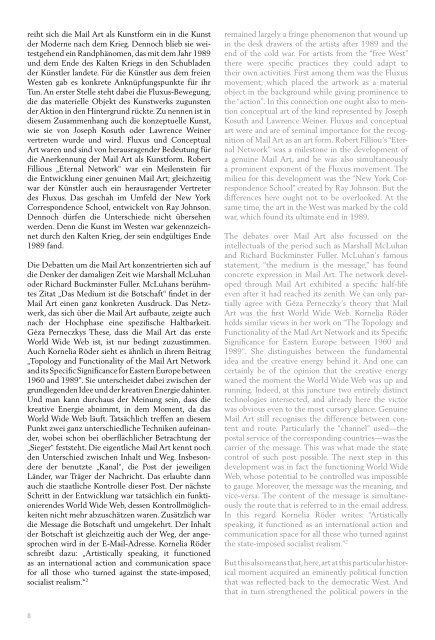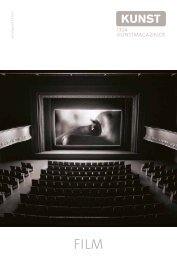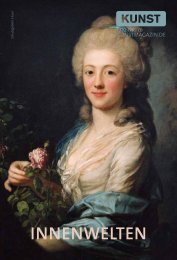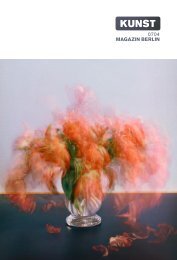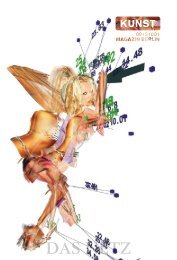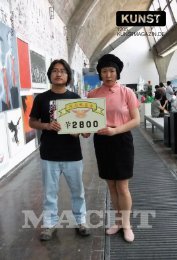Download als .pdf - KUNST Magazin
Download als .pdf - KUNST Magazin
Download als .pdf - KUNST Magazin
Sie wollen auch ein ePaper? Erhöhen Sie die Reichweite Ihrer Titel.
YUMPU macht aus Druck-PDFs automatisch weboptimierte ePaper, die Google liebt.
eiht sich die Mail Art <strong>als</strong> Kunstform ein in die Kunst<br />
der Moderne nach dem Krieg. Dennoch blieb sie weitestgehend<br />
ein Randphänomen, das mit dem Jahr 1989<br />
und dem Ende des Kalten Kriegs in den Schubladen<br />
der Künstler landete. Für die Künstler aus dem freien<br />
Westen gab es konkrete Anknüpfungspunkte für ihr<br />
Tun. An erster Stelle steht dabei die Fluxus-Bewegung,<br />
die das materielle Objekt des Kunstwerks zugunsten<br />
der Aktion in den Hintergrund rückte. Zu nennen ist in<br />
diesem Zusammenhang auch die konzeptuelle Kunst,<br />
wie sie von Joseph Kosuth oder Lawrence Weiner<br />
vertreten wurde und wird. Fluxus und Conceptual<br />
Art waren und sind von herausragender Bedeutung für<br />
die Anerkennung der Mail Art <strong>als</strong> Kunstform. Robert<br />
Fillious „Eternal Network“ war ein Meilenstein für<br />
die Entwicklung einer genuinen Mail Art; gleichzeitig<br />
war der Künstler auch ein herausragender Vertreter<br />
des Fluxus. Das geschah im Umfeld der New York<br />
Correspondence School, entwickelt von Ray Johnson.<br />
Dennoch dürfen die Unterschiede nicht übersehen<br />
werden. Denn die Kunst im Westen war gekennzeichnet<br />
durch den Kalten Krieg, der sein endgültiges Ende<br />
1989 fand.<br />
Die Debatten um die Mail Art konzentrierten sich auf<br />
die Denker der damaligen Zeit wie Marshall McLuhan<br />
oder Richard Buckminster Fuller. McLuhans berühmtes<br />
Zitat „Das Medium ist die Botschaft“ findet in der<br />
Mail Art einen ganz konkreten Ausdruck. Das Netzwerk,<br />
das sich über die Mail Art aufbaute, zeigte auch<br />
nach der Hochphase eine spezifische Haltbarkeit.<br />
Géza Perneczkys These, dass die Mail Art das erste<br />
World Wide Web ist, ist nur bedingt zuzustimmen.<br />
Auch Kornelia Röder sieht es ähnlich in ihrem Beitrag<br />
„Topology and Functionality of the Mail Art Network<br />
and its Specific Significance for Eastern Europe between<br />
1960 and 1989”. Sie unterscheidet dabei zwischen der<br />
grundlegenden Idee und der kreativen Energie dahinter.<br />
Und man kann durchaus der Meinung sein, dass die<br />
kreative Energie abnimmt, in dem Moment, da das<br />
World Wide Web läuft. Tatsächlich treffen an diesem<br />
Punkt zwei ganz unterschiedliche Techniken aufeinander,<br />
wobei schon bei oberflächlicher Betrachtung der<br />
„Sieger“ feststeht. Die eigentliche Mail Art kennt noch<br />
den Unterschied zwischen Inhalt und Weg. Insbesondere<br />
der benutzte „Kanal“, die Post der jeweiligen<br />
Länder, war Träger der Nachricht. Das erlaubte dann<br />
auch die staatliche Kontrolle dieser Post. Der nächste<br />
Schritt in der Entwicklung war tatsächlich ein funktionierendes<br />
World Wide Web, dessen Kontrollmöglichkeiten<br />
nicht mehr abzuschätzen waren. Zusätzlich war<br />
die Message die Botschaft und umgekehrt. Der Inhalt<br />
der Botschaft ist gleichzeitig auch der Weg, der angesprochen<br />
wird in der E-Mail-Adresse. Kornelia Röder<br />
schreibt dazu: „Artistically speaking, it functioned<br />
as an international action and communication space<br />
for all those who turned against the state-imposed‚<br />
socialist realism.“ 2<br />
remained largely a fringe phenomenon that wound up<br />
in the desk drawers of the artists after 1989 and the<br />
end of the cold war. For artists from the “free West”<br />
there were specific practices they could adapt to<br />
their own activities. First among them was the Fluxus<br />
movement, which placed the artwork as a material<br />
object in the background while giving prominence to<br />
the “action”. In this connection one ought <strong>als</strong>o to mention<br />
conceptual art of the kind represented by Joseph<br />
Kosuth and Lawrence Weiner. Fluxus and conceptual<br />
art were and are of seminal importance for the recognition<br />
of Mail Art as an art form. Robert Filliou’s “Eternal<br />
Network” was a milestone in the development of<br />
a genuine Mail Art, and he was <strong>als</strong>o simultaneously<br />
a prominent exponent of the Fluxus movement. The<br />
milieu for this development was the “New York Correspondence<br />
School” created by Ray Johnson. But the<br />
differences here ought not to be overlooked. At the<br />
same time, the art in the West was marked by the cold<br />
war, which found its ultimate end in 1989.<br />
The debates over Mail Art <strong>als</strong>o focussed on the<br />
intellec tu<strong>als</strong> of the period such as Marshall McLuhan<br />
and Richard Buckminster Fuller. McLuhan’s famous<br />
statement, “the medium is the message,” has found<br />
concrete expression in Mail Art. The network developed<br />
through Mail Art exhibited a specific half-life<br />
even after it had reached its zenith. We can only partially<br />
agree with Géza Perneczky’s theory that Mail<br />
Art was the first World Wide Web. Kornelia Röder<br />
holds similar views in her work on “The Topology and<br />
Functionality of the Mail Art Network and its Specific<br />
Significance for Eastern Europe between 1960 and<br />
1989”. She distinguishes between the fundamental<br />
idea and the creative energy behind it. And one can<br />
certainly be of the opinion that the creative energy<br />
waned the moment the World Wide Web was up and<br />
running. Indeed, at this juncture two entirely distinct<br />
technologies intersected, and already here the victor<br />
was obvious even to the most cursory glance. Genuine<br />
Mail Art still recognises the difference between content<br />
and route. Particularly the “channel” used—the<br />
postal service of the corresponding countries—was the<br />
carrier of the message. This was what made the state<br />
control of such post possible. The next step in this<br />
development was in fact the functioning World Wide<br />
Web, whose potential to be controlled was impossible<br />
to gauge. Moreover, the message was the meaning, and<br />
vice-versa. The content of the message is simultaneously<br />
the route that is referred to in the email address.<br />
In this regard Kornelia Röder writes: “Artistically<br />
speaking, it functioned as an international action and<br />
communication space for all those who turned against<br />
the state-imposed socialist realism.” 2<br />
But this <strong>als</strong>o means that, here, art at this particular historical<br />
moment acquired an eminently political function<br />
that was reflected back to the democratic West. And<br />
that in turn strengthened the political powers in the<br />
Edgardo-Antonio Vigo und Graciela Gutiérrez Marx: La Plata/Argentinien an Guillermo Deisler,<br />
Plovdiv/Bulgarien, 20.10.1978 (recto), Akademie der Künste, Kunstsammlung<br />
Das aber bedeutet, dass Kunst zu diesem Zeitpunkt<br />
innerhalb der Geschichte eine eminent poli tische<br />
Funktion bekam, die zurückstrahlte in den demokra <br />
tischen Westen. Das wiederum stärkte die politischen<br />
Kräfte im Osten, die für eine Demokratisierung<br />
kämpften. Mail Art war dafür in dem gegebenen histo <br />
rischen Moment von nicht zu unterschätzender Bedeutung.<br />
Man könnte vermuten, dass die Personen hinter der<br />
Mail Art nur eine Minderheit vertreten. Das mag am<br />
Beginn der Bewegung so gewesen sein, aber danach<br />
eroberte sie den öffentlichen Raum, wenn man diesen<br />
unter einem kommunistischen Regime <strong>als</strong> einen solchen<br />
East that were struggling for democratisation. In this<br />
respect Mail Art obtained a significance at this particular<br />
historical moment that can scarcely be overestimated.<br />
One is tempted to suppose that the people behind<br />
Mail Art represented only a minority. Perhaps that was<br />
so at the beginning of the movement, but thereafter<br />
the movement managed to conquer public space, insofar<br />
as one can speak of public space in a communist<br />
regime. Under these conditions Mail Art was a sort of<br />
megaphone for everything that had no voice in public<br />
space. This function and its significance cannot be<br />
compared with the Mail Art in the West. For here one<br />
8 9


